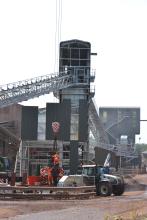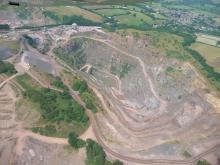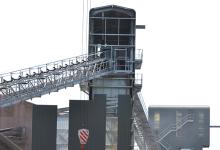%$Linker:
A plant upgrade and several improvement measures at BluRock Quarries – anchored by a huge investment in new generation
With technology constantly advancing, industries are looking for ways to utilise the latest innovations to help their businesses run efficiently and maximise growth opportunities. A case in point is Blurock Quarries, a family-owned quarry located in the heart of Estcourt, a small town in the uThukela District of KwaZulu-Natal Province, South Africa, which committed a huge investment in a major plant upgrade with new technology equipment that has significantly boosted capacity and increased operational efficiencies.
Blurock Quarries mines a dolorite rock with some sandstone intrusions. After the overburden layer, which is stockpiled for rehabilitation, comes a layer of weathered rock, a mixture of shale and sandstone, which is crushed to produce sub-base material (G5 and G7). Below that formation is a mixture of dolorite and a competent sandstone, which is used to manufacture G2 and general concrete products. Below that layer lies the clean dolorite, used to make road stone (20mm, 14mm and 10mm), as well as 26mm concrete stone and crusher dust. The biggest selling products at the moment are the 20mm concrete stone, crusher dust, G5 and road stone (20mm, 14mm and 10mm).
Since taking the reins as CEO of the family-owned enterprise back in 2015, after having served as the manager since 2010, Jeremy Hunter-Smith has focused his efforts on taking the business to the next level. He tells Aggregates Business International that following several recent interventions, the business has grown from strength to strength. Significant among some of the key initiatives in recent years was the investment in new generation Sandvik crushing and screening equipment for the upgrade of the secondary and tertiary stages of the main processing plant. This was followed by recent investments in the modernisation of enabling infrastructure – new powerline, new substation, new switch room and a new control room, among others.
“In recent years we have focused on upgrading ourselves to be in line with the technological revolution. With the market slowdown, we have put our efforts into increasing efficiencies. A dip in the market can actually be an eye opener for a business – it has driven us to refocus our efforts on things that really matter, such as cutting wastages and driving efficiency in every way possible,” says Hunter-Smith.
Prior to the plant upgrade, Blurock Quarries operated an old processing plant that lacked capacity, efficiency and flexibility. The primary crusher was a Nordberg 1109 jaw crusher. It was a very old unit, one of only four brought into the country way back. From there, material was sent to a
From there, material would go to the intermediate stockpile, from which it would be fed into a
In 2016, Blurock engaged the services of a business development consultant, Deon Bosman, who suggested a growth and development plan for the operation. Based on Bosman’s previous experience with the Sandvik product, he recommended Sandvik Mining and Rock Technology South Africa to Blurock Quarries.
In 2016, BluRock started looking at areas where efficiencies could be created. The first Sandvik machine to be purchased was the CH440 cone crusher. Adam Taylor, Lifecyle Services Manager – Crushing and Screening at Sandvik Mining and Rock Technology South Africa, says the CH440 is suitable for a high-capacity secondary application or a high-reduction tertiary or pebble-crushing application, and it can be matched to changes in production through the selection of crushing chambers and an eccentric throw. The flexibility means that it’s suitable for a wide range of applications.
In this instance, the CH440 was deployed as a tertiary crusher, replacing both the Metso HP300 and the Telsmith 36/7” fine cone. “We removed two crushers and replaced them with a single, new generation crusher,” says Hunter-Smith. “Apart from an increase in crushing throughput, this simplified our plant layout and having one crusher in the tertiary crushing stages, instead of two, reduced our maintenance effort,” says Hunter-Smith.
The Telsmith 36/7” fine cone was an old crusher which called for regular maintenance, which in turn resulted in unwanted downtime. In addition, maintenance of the old Telsmith posed safety hazards for the maintenance crew because its older technology did not have means to lift the top of the crusher hydraulically like the new generation Sandvik CH440. This feature has resulted in a reduction in downtime related to clearing blockages, which have been reduced from three hours on the old crusher, to about half an hour on the new crusher.
With the new CH440, Hunter-Smith also opted for Sandvik’s Automatic Setting Regulation control system (ASRi), which enables real-time performance management, allowing the machine to consistently run at optimum levels. “When a Sandvik CH440 cone crusher is equipped with ASRi, it automatically adapts the crusher to variations in feed conditions. By continuously measuring and compensating for crusher liner wear, the automation system allows for full utilisation of crusher liners and schedules liner replacements to coincide with planned maintenance stops. It also assists in keeping the crusher choke fed. This maximises rock-on-rock crushing, which helps to optimise the quality of the final product,” explains Taylor.
Installing the Sandvik CH440 has altered the whole tertiary section setup while producing the exact quality that was achieved by having a fine cone crusher in the mix, says Hunter-Smith. “Another major benefit is that we have managed to relieve the pressure on our VSI. We are able to reduce the speed of the VSI due to the CH440’s attrition crushing. Reducing speed on the VSI also lowers the amount of 0,075mm material in our crusher dust. Our concrete and asphalt manufacturing customers want as little 0,075mm as possible in their crusher dust,” explains Hunter-Smith.
Along with the Sandvik CH440, Blurock purchased the SV1252 vibrating grizzly feeder (VGF). This feeds the Nordberg 1109 primary crusher and was bought to improve feeding capacity at the primary crusher. “In terms of selection, we looked at other manufacturers, but the Sandvik VGF fitted perfectly into our existing structure. Our previous VGF created a bottleneck as we could not get enough feed into the jaw, so were not running the jaw full. That resulted in poor liner wear and poor attrition crushing,” adds Hunter-Smith.
In early 2017, Blurock started looking at its whole secondary crushing application. It engaged the services of Imilingo Mineral Processing, which designed the new secondary crushing layout. The quest to improve efficiencies at the secondary crushing stage started with the purchase of a Sandvik CS430 cone crusher. This was purchased in 2016, but was only installed in 2018. “It was the exact crusher we needed to upgrade our whole secondary crushing application,” says Hunter-Smith.
As part of the new layout, a Sandvik SS1633H scalping screen was bought in November 2017. “We started installation in December 2017 and commissioned in June 2018. The reason we selected this particular scalping screen was because of its compact build and high throughput, which allowed us to sidestep the space constraints we had onsite,” says Hunter-Smith.
The Sandvik CS430 cone crusher was purchased because Blurock wanted to create flexibility by being able to take out some of the products at the scalping screen before and just after the secondary crushing stage, before the product reported to the intermediate stockpile. This has also been made possible by the CS430’s ability to produce a better aggregate shape earlier in the crushing process.
In terms of plant design, the Sandvik CS430 cone crusher has been designed to allow the crusher to run either full or empty, with a dedicated feed bin feeding into it. “We built a big feed bin before the cone crusher, which is good crushing practice because you have the necessary continuous feed into the crusher,” says Hunter-Smith. “Once everything has been set up, we will install an automated door on the feed bin – if the crusher is full, it will stay open, but if there isn’t enough material in the bin, it will close the door and wait for the bin to fill so that the crusher will never run three-quarters or half full. It will either be full or empty – that’s the best way to run a cone crusher.”
The scalping screen allowed Blurock to take out some of the product at the secondary stage. From the new Sandvik SS1633H scalping screen, they are now able to take out a handstone, G5, general concrete stone and dump rock material. “The investment into a scalping screen and the whole secondary setup was to facilitate the manufacture of all products that we want using our main plant, instead of having to rely on our mobile crushing and screening train for some of the products. The secondary stage upgrade is definitely money well spent,” says Hunter-Smith.
The results of the plant upgrade are apparent – with the old plant system, Blurock had the capacity to produce about 100tonnes/hour. “We were very limited because of the old equipment we had. Following the upgrade – through Sandvik product and other efficiency improvement measures – we are now able to produce between 170 and 180tonnes/hour,” concludes Hunter-Smith.
%$Linker:











